The Year of the Supper Club
Issue #33, January 11, 2025: Hello from San Diego, What is a supper club?, Featured member, How to make fresh pasta, Supper club pasta recipes, + A recipe from the new cookbook
Happy 2025, friends and greetings from San Diego!
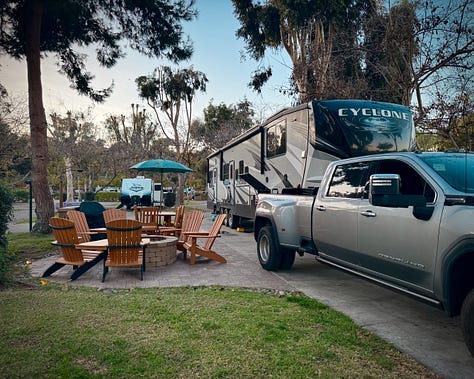
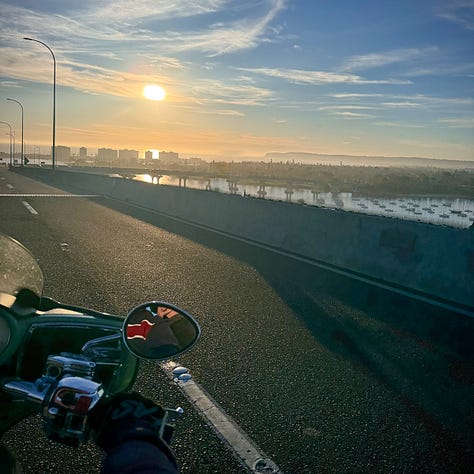

After spending the holidays in Colorado, we made our way to San Diego last weekend, missing a major snowstorm by days. I tend to begin each new year full of optimism and not having to pack up and leave in a snowstorm seems like a good omen.
If you’re new here, welcome! Since this is the first issue of the year, here’s what you can expect…
The Lost Supper Club is a community of people who love to learn about the world through the people who live there and the recipes they cook.
As a supper club member, you’ll find inspiration from other cooks and bakers from across the country. Food is an enormous part of our individual and collective history and one way to learn about people is to step into their kitchens. That’s what we do here.
The Lost Supper Club is for everyone who:
is craving connections with people outside their current social circle and also wants to deepen the connections with their own community of friends and neighbors
is curious about how other people live, what they think, and what their stories are
loves the idea of learning about the world through the people who live there and the recipes they cook.
The supper club is for paid subscribers BUT for the month of January, it will be free for every subscriber. If you love it here, I hope you’ll stay.
Lost Supper Club emails will arrive in your in-box every other Saturday morning, alternating with the Let’s Get Lost Newsletter, which is free for every subscriber.
Read more about me, the Let’s Get Lost Newsletter and the Lost Supper Club on the About Page. And, if you have questions about anything, please let me know! Leave a comment below or send an email to me at rebecca@rebeccablackwell.com
What is a supper club?
Traditionally, the word supper club refers to a dining establishment that’s more of a social club with food. They became popular in the 1930’s and ‘40’s as a destination for the entire evening, rather than a restaurant where you stop in for a meal and leave.
In the U.S., you’ll find more supper clubs in the midwest than anywhere else in the country and most of them aren’t quite the all-night hangout of the past, but the concept is still the same. A supper club is a place you go to socialize over cocktails and food, often with live music or entertainment.
In the southern states, supper club has a different meaning. Southern supper clubs are made up of groups of friends who agree to get together for dinner on a regular basis. Generally, members take turns hosting, and while the food is certainly important, friendship and connection are what southern supper clubs are all about.
In one of the final issues of 2024, I wrote about a book club I attended for 10 years that was really a supper club of book lovers. Even though we used books as the reason for our monthly gatherings, we were there primarily for friendship and connection, and there was always plenty of good food.
Supper clubs can be formal or casual, highly organized or spontaneous, and include any number of people. The what, when, and where isn’t as important as the who. The who is the entire reason to attend or host a supper club.
For the most part, connection doesn’t just happen. You have to be deliberate about it.
This year, I will be hosting and attending supper club meetings all over the country, most of them with some of YOU.
This very evening, Steve and I will gather around a table with some of our closest friends (and Lost Supper Club members) over a meal in Palm Springs.
The weekend after that,
and I will host a Lost Supper Club at our RV, with a small group of friends in San Diego.In February, we’ll meet up with Holly Coppedge of Entertaining the RV Life for a Lost Supper Club meeting in San Antonio.
Later that month, we’ll gather at the home of the absolute QUEEN of southern hospitality for a super club that will knock your socks off. After that, there will be supper club meetings in northern Louisiana, Oklahoma, Colorado, Michigan, Kansas City, and a handful of other places along the way.
As Lost Supper Club Members, I’ll take you along with photos, recipes, and tips from other Supper Club members as well as inside information about the places we visit.
If you live in, or near, one of the places we will visit this year (here’s our itinerary) and you’d like to connect, please leave a comment or send an email to rebecca@rebeccablackwell.com.
Regardless of whether I get to meet you in person this year, I hope you’ll come along for the ride. But even more than that, I hope you’ll be inspired to start your own supper club.
3 reasons to start a supper club
Scheduled connection. You’ll actually get together with your favorite people on a regular basis instead of saying things like, we have to get together soon. When I had a book club, we got together once a month on a Sunday evening. The date changed from month to month and occasionally 6 weeks went by instead of 4, but without the intention of once a month Sunday meetings, it’s unlikely we would have managed to make it happen.
It’s a great excuse to make and eat really delicious food withe people you like to hang out with.
We all need more face-to-face time and less screen-to-screen time.
6 supper club ideas that I love
Supper clubs can be a scheduled gathering with a small group of friends or casual get togethers thrown together at the last minute. They can be at members’ homes, at a restaurant, on a beach, or in a park. There are no rules except the ones you create together.
I talked to a woman recently who told me that she was a part of a supper club of 10 women who met 10 times a year, once at each member’s home.
I’ve read about supper clubs that decide on different themes for each meeting. For example, holiday themes, food themes (fried chicken with all the fixings), movie inspired themes, a historical decade (the 1920s or the 1950s), event themes (the Kentucky Derby), you get the picture.
For my book club, the host provided the main dish and everyone else brought an appetizer, side, or dessert. Regardless of whether we were hosting or making something to bring along, we all used it as an excuse to make something fun, often inspired by whatever book we were reading.
If your supper club is full of foodies, use it as an opportunity for a culinary adventure. Work as a group to plan elaborate 5- star menus down to the smallest details—from ingredients to companion beverages to decor. Likewise, if your group is made up of wine lovers, organize food to go with wine tastings.
Use supper club gatherings as a way to deepen cultural roots. For example, I talked with a woman who came to the U.S. from India when she was a child. She gets together with other Indian immigrants once a month to eat the foods of their childhood. Alternatively, gatherings could feature the culinary traditions of the different cultures in your group.
In 2010,
, founder of the , created the Clandestine Cake Club. Each meeting took place at a different, secret location and had a theme. Members showed up with their creations and everyone spent the evening hanging out and eating cake. Over time, Lynn inspired over 150 Clandestine Cake Clubs to form all over the world. I just LOVE this idea and think it would translate beautifully to a supper club. (Check out The Clandestine Cake Club Cookbook.)
Are you a part of a supper club? Or, have you been a part of one in the past? I’d love to hear about your experience!
Featured supper club member
Meet my friend Judy. Judy is the kind of person who can make anyone feel at home in her home. Both her and her husband Jeff are quintessential hosts and have friend over for dinner several times a week. This is significant in a world where having people over for dinner has become somewhat of a lost art.
Judy grew up in a middle class neighborhood in the city of Chicago and she learned how to cook at a young age. Her parents both worked full time jobs so most nights, she’d come home from school and get dinner started.
After marrying her college sweetheart, Judy and her husband Jeff moved to New Jersey for a few years before settling in California, where they’ve lived ever since. Despite the busyness of raising 4 kids, Judy made a home cooked meal most nights and they often had dinner guests.
Her cooking has evolved over the years, but one of the things that’s remained steadfast is the open arms with which she welcomes people into her kitchen.
Steve and I have had dinner at Judy’s home more times than I could count. She is the kind of host that laughs easily, makes everything look effortless, and listens in a way that let’s you know she is interested in whatever it is you have to say.
Judy loves to cook, but more than that, she loves to cook for other people. She keeps a folder of recipes that look interesting to her and is more interested in trying something new than relying on the tried and true. She’s an adventurous cook and eater and is open to trying nearly everything.
She is also the pasta making queen. Judy taught me to make fresh pasta in 2018 and I’ve never looked back. I was surprised at the simplicity of the process and it’s so delicious that the small amount of effort required is always worth it.
Pasta making with Judy
I took the photos below are from my first pasta-making lesson with Judy!
Here’s what you’ll need:
1 ¾ cups (210 grams) all-purpose flour + more if necessary
1 whole egg
6 large egg yolks
2 teaspoon extra virgin olive oil
1 tablespoon whole milk
Here’s how to make it:

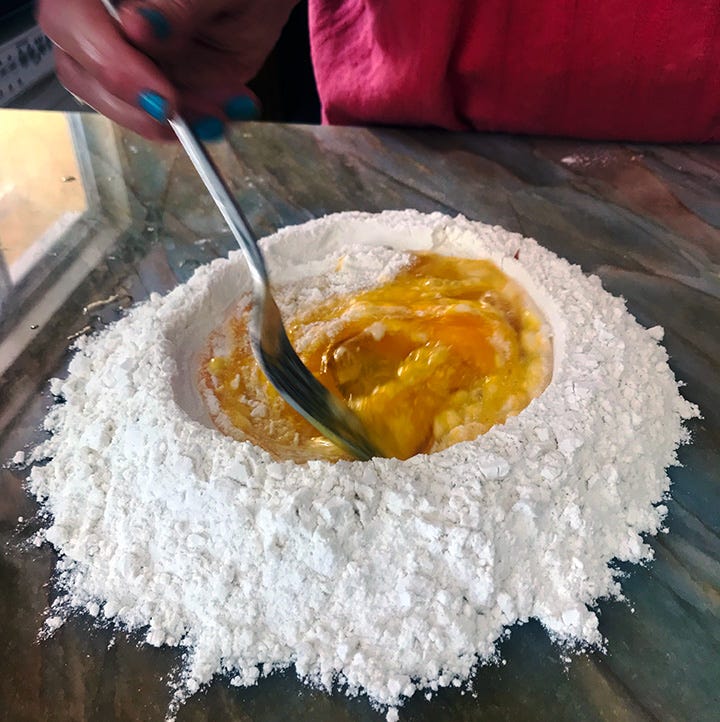
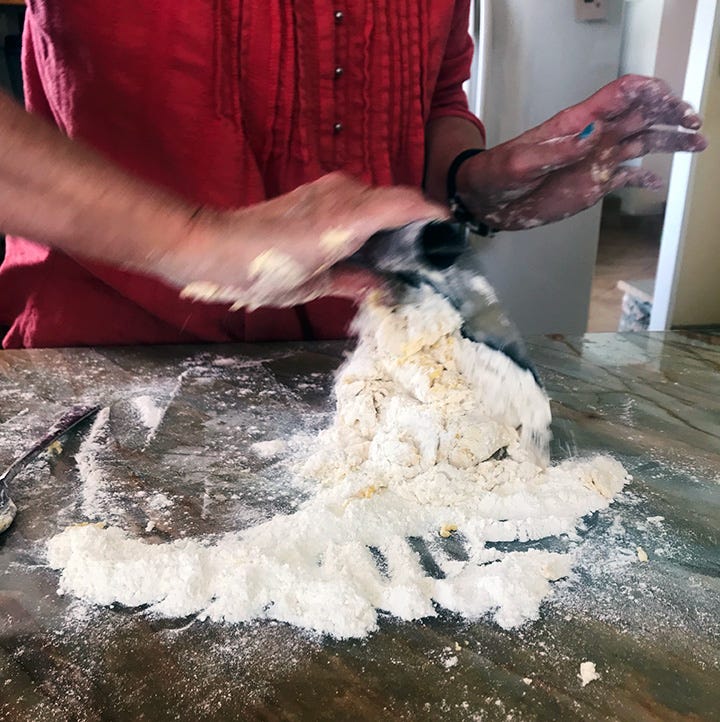

Add the flour to a large bowl or in a pile it onto a work surface. Use your hands to create a well in the center of the flour that's large enough to contain the eggs.
Crack the egg and egg yolks into a bowl and use a small whisk or a fork to break them up and blend them together.
Pour the eggs into the well you created in the flour and add the milk and olive oil. Use a fork to slowly begin to whisk the eggs into the flour.
As you continue to incorporate more flour into the eggs, the mixture will begin to turn into a dough. Mixing the flour into the eggs bit by bit will help to create a smooth dough from the start.
If you’ve been mixing the dough in a bowl, dump the whole mess out onto a clean work surface when it becomes thick and difficult to whisk. At this point, it's unlikely that all of the flour has been incorporated, which is ok.
Use your hands to knead the dough, incorporating as much flour as possible. The goal is to continue to add enough flour to get a dough that is smooth and pliable but not sticky.
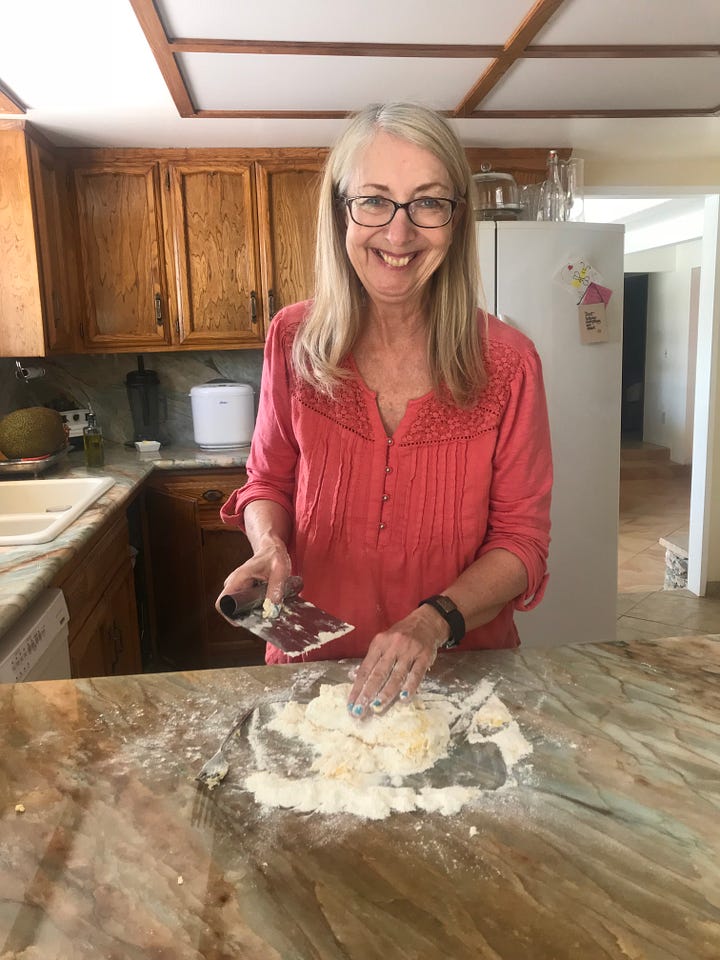

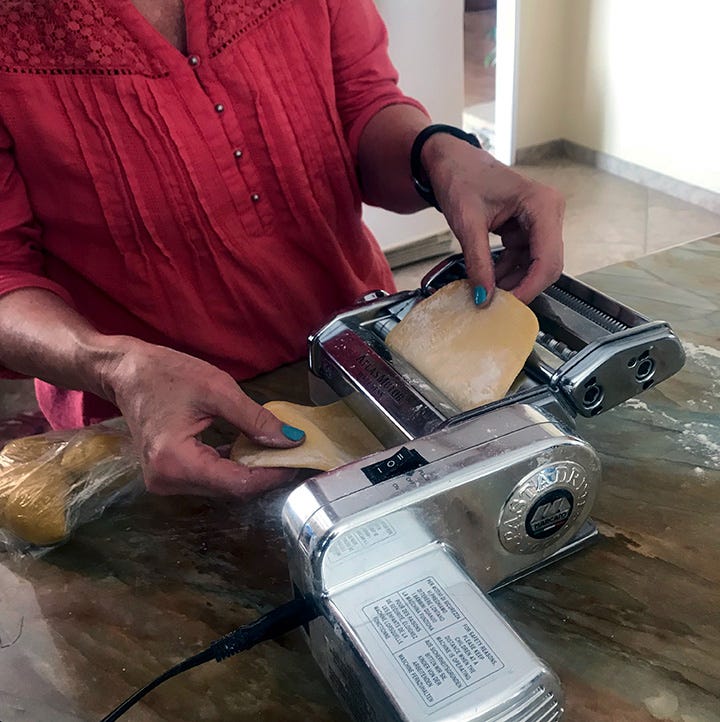

It's important to knead the dough for at least 10 minutes. The dough will be soft at first; as you knead, incorporate more and more of the flour. Continue kneading until you have a smooth elastic ball of dough that is not sticky at all, but not so dry that it's cracking. This will take at least 10 minutes. If you slice the dough with a sharp knife, you should see very few air bubbles.
Wrap the dough tightly in plastic wrap and place it in the refrigerator. Allow it to rest in the refrigerator for at least 5 hours and up to a week.
When you're ready to roll out the dough and cut it into noodles or lasagna sheets, remove it from the refrigerator, unwrap it, and set it on a surface that's been dusted with flour. Cut it into 4 equal pieces. Work with one piece at a time, keeping the remaining dough covered.
Take one piece of dough and feed it through the rollers of a pasta machine set to it's widest setting. On my Marcato Pasta Maker, this means setting the rollers to "0".
After rolling it through the machine, fold it in half and roll it through again. Continue this process of folding the dough in half and feeding it through the rollers with the machine at it's widest setting another 8 - 10 times. If at any point, the dough gets sticky, dust it with flour.
Continue to feed the dough through the machine's rollers as you slowly narrow the width of the rollers. On my machine, the widest setting is "0", so I first narrow the rollers to "1" and feed the dough through then narrow it to "2" and feed it through again, and so forth. Dust the pasta with flour as often as necessary to keep it from feeling sticky.
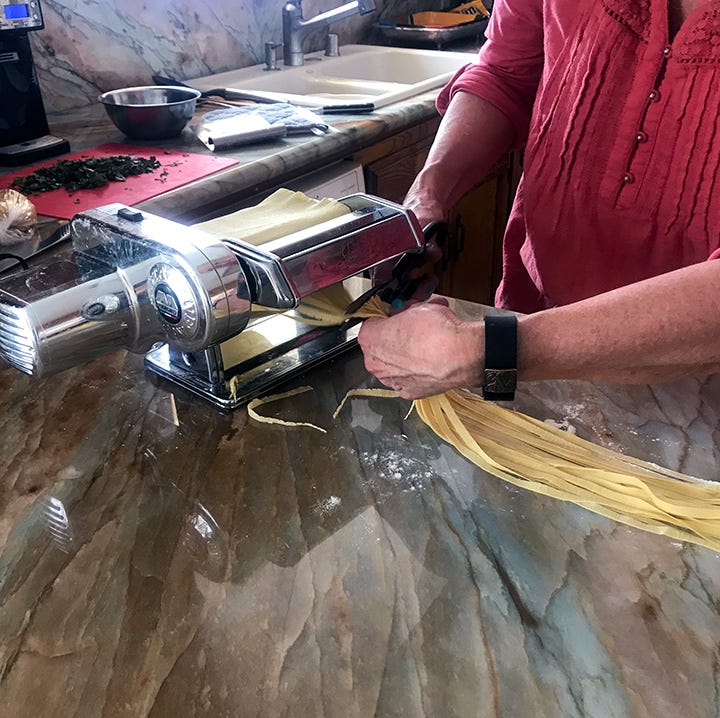
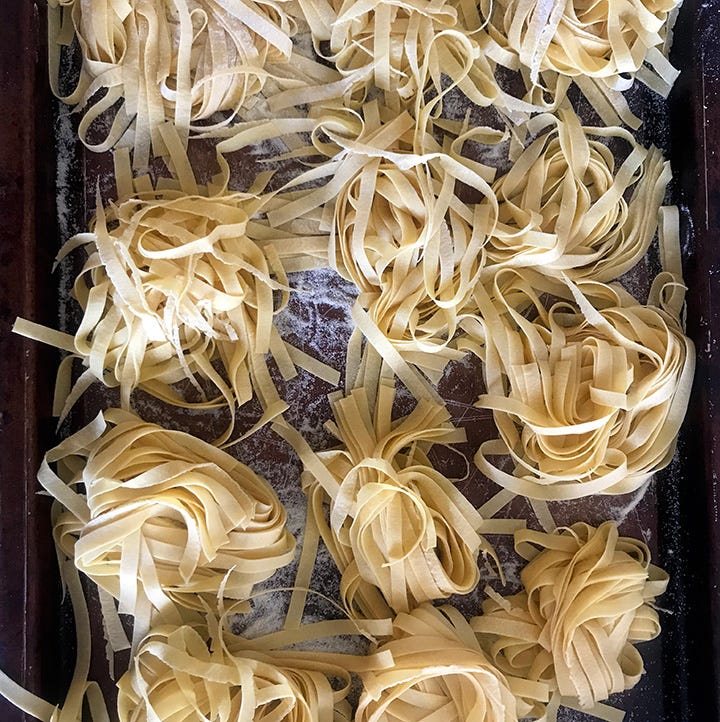
I rarely roll the pasta thinner than setting "4" or "5" on my machine because I prefer fat, chewy noodles. But, this is a matter of personal preference, so experiment to discover how thin you prefer the pasta to be before cutting it into noodles.
Roll the sheet of pasta through the noodle cutting attachment to cut it into strands of spaghetti or fettuccini.
Hang the noodles on a pasta drying rack. Alternatively, you can hang them on clothes hangers that you suspend from the knobs of your kitchen cabinets. You can also just lay the noodles out on a tray but make sure they are dusted with enough flour to prevent their sticking together.
The pasta can be cooked immediately or given time to dry. I prefer the flavor and consistency of dried pasta, so recommend allowing the pasta to dry for at least a couple of hours before cooking. I usually cut the noodles the day before I want to cook them and allow them to dry overnight. Once the noodles are dry, you can store them for weeks in an airtight container.
To cook the pasta, fill a pot with water and add enough salt to make the water taste salty. Set the pot over high heat and bring the water to a boil. Add the pasta and cook until the noodles are al dente (a texture that's tender but also firm and chewy).
Supper Club worthy pasta recipes
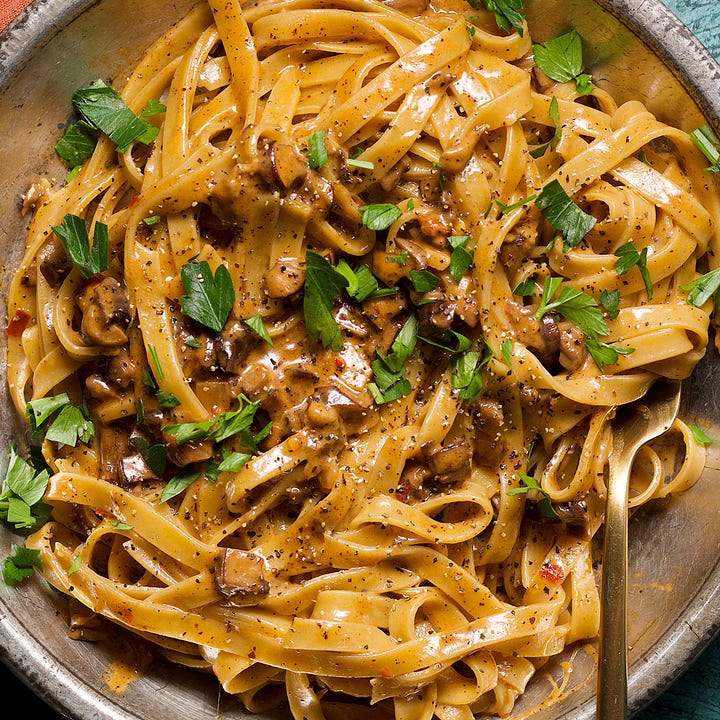

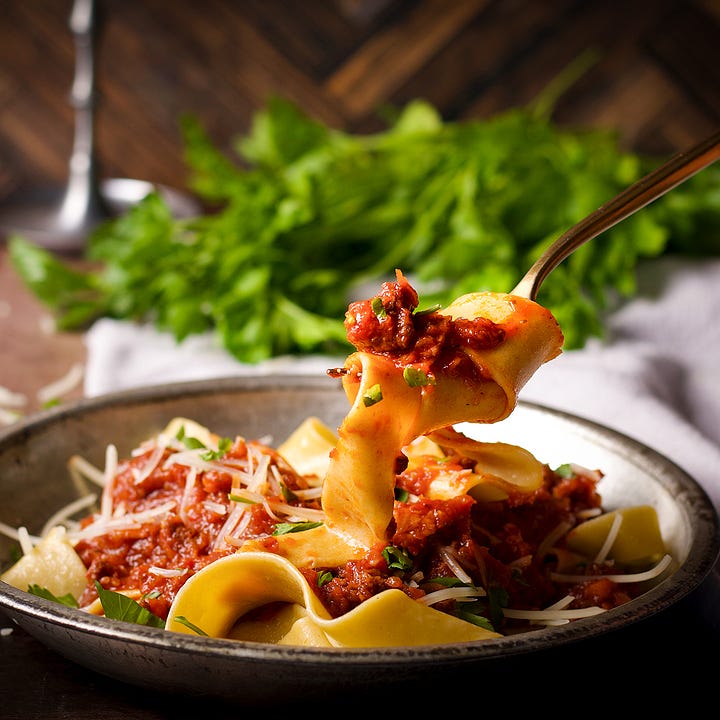

Creamy Mushroom Pasta: The recipe is one of my many favorite ways to use mushroom ragu - a hearty, saucy, roasted mushroom sauce that can be spooned over pasta, potatoes, polenta, or eggs. Use mushroom ragu to make the most incredible mushroom pizza and white mushroom lasagna. Or, add it to soups or stews, spread over bread or toast, tuck it into homemade ravioli or flatbread, and spread over sandwiches. It is truly one of the most versatile recipes I know. Mushroom ragu is also incredibly flavorful, so all you need to do to transform it into a creamy pasta sauce is add some cream and parmesan cheese.
Shrimp Scampi. This recipe from the Barefoot Contessa is one of Judy’s go-to recipes for spontaneous entertaining because she almost always has all of the ingredients on hand.
Pasta Bolognese: Meaty, rich, and slow simmered bolognese sauce is one of the world's all-time greatest comfort foods. This recipe is a bit untraditional in that it includes bacon and red wine. But try it and you just might find a new favorite. Direct quote from Judy: “This is my go-to for sure. The only changes I made were to substitute pancetta for the bacon and a less red peppers. I love that it comes together with just a couple hours of simmer. And the leftovers are even better.”
Skillet Vegetable Lasagna: This cheesy, saucy vegetarian lasagna is packed with zucchini, cauliflower, walnuts, mushrooms, roasted red peppers, sun-dried tomatoes, onions, and garlic all layered up with creamy parmesan béchamel, pasta, and three kinds of cheese. The veggies are chopped up in a food processor and create a meaty texture that's as close to cozy lasagna perfection as you can get.
Entertaining tips from Judy
Keep things in your freezer that can be pulled out at a moment’s notice. Judy likes to keep balls of chocolate chip pecan cookie dough in her freezer, that are ready to bake. But honestly, Judy’s freezer is a well organized treasure trove of delicacies. She often makes extra of things like mushroom ragu or bolognese sauce so that she can pack some into her freezer for impromptu dinner parties.
A few freezer tips: Freeze an entire peeled knob of ginger and then just grate what you need when you need it. Keep an ice cube tray of fresh squeezed lemon and lime juice in the freezer as well as some zest. Freeze those little bits of heavy cream or coconut milk that always seem to be left over then pop the frozen cubes into soups or sauces for some extra creaminess. Label everything, and organize the freezer into groups of similar ingredients so you can find what you’re looking for.
Judy likes to serve cocktails before a meal along with a light snack. She stays away from heavy appetizers because she’s found that guests aren’t hungry for the main meal, or leave feeling overly full.
Judy loves The NY Times cooking section but pays special attention to the comments on recipes. It’s through the comments that she often learns the advantages and pitfalls of a recipe as well as useful additions and substitutions.
She tries to make things ahead of time because she doesn’t want to be exhausted when her guests arrive. She wants to try new recipes and spoil her guests with a really good meal, but also wants to have enough energy to enjoy the evening.
An inside peak!
Let’s Get Lost, the Cookbook Vol 1 will be released later this month and this is one of the recipes you’ll find within its pages.
That’s all for now, friends. I hope you have a delightful week and, if you are enjoying this newsletter, please tell your friends.
If you make something from this issue, have questions or anything you’d like to share, add a comment below. I ❤️ to hear from you.
xo
-Rebecca





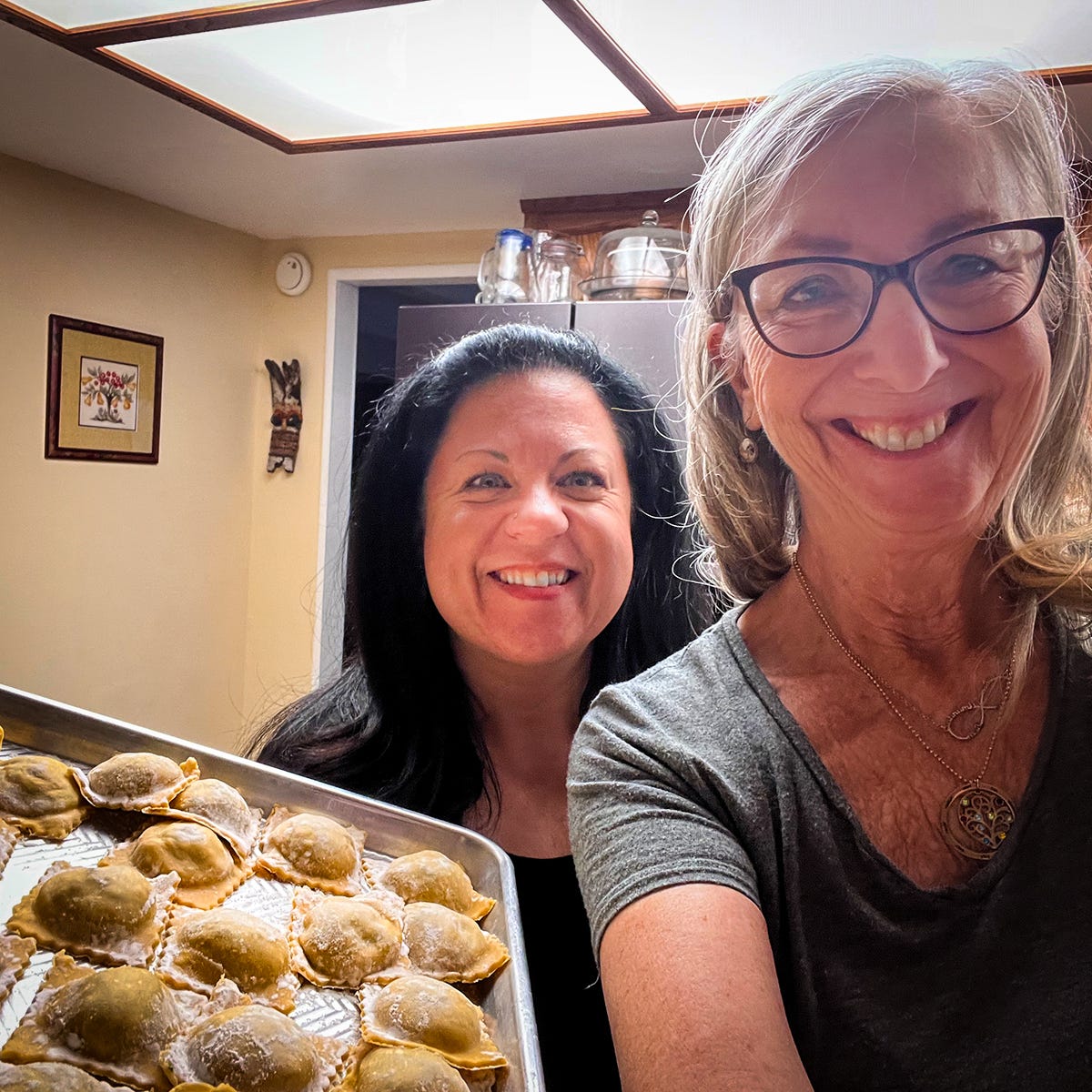



Thank you for sharing!
Thank you for the mention. I love this idea of yours. Bringing people together, making new connections and learning from each other. During my Clandestine Cake Club years and Secret Tea Room years - tea and cake in my own home, I connected with so many people I would never have met otherwise, and they, too, made new connections. Arriving as strangers, and leaving as friends.